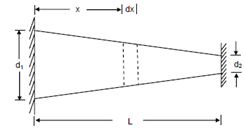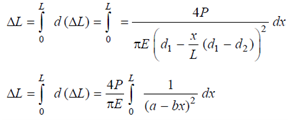Fully Restrained Tapered Bar:
Consider the bar shown in Figure that is circular in cross-section but tapering from a diameter d2 to d1 over the length L. The bar is fully restrained at its ends. Presently, let the temperature of the bar increased through ΔT.

Figure
If the bar were not restrained but free to expand it would have extended through an amount ΔL, given by
ΔL = α L ΔT
Because of the restraint, a compressive force P would have developed within the bar whose effect is to generate a contraction equivalent to ΔL. Under this force, a cross-section at a distance x from the larger end would have established a stress, σx, equal to P/Ax, where Ax is the area of that cross-section.
∴ σx = P/Ax = 4P/ π(d2 +(L-x)/L (d1-d2)2)
4P/ π(d1 -x/L (d1-d2)2)
The strain at that cross-section, εx, can be written as
εx = σx/E = 4P/Eπ ( d1 -x/L(d1 - d2 ) )2
Under this strain, a small element of the bar of length dx would have changed its length by d (ΔL) given by
d (ΔL) = εx dx = 4P dx/πE ( d1 -x/L (d1 - d2 ) )2
The total change in length ΔL can then be obtained by integrating the above expression.

where, a = d1 and b = d1 -d2/L
Now, on writing (a - bx) = t, we get dx =- dt/b.
Substituting these,

= 4P/ ?bE [1/a-bx]L0 = 4P/ ?E [1/d1-(d1-d2/L)x]L0 [L/d1-d2]
= 4PL/ ?Ed1d2
∴ 4PL/?Ed1d2 = L α ΔT
So the compressive force generated in the bar due to restraining the free expansion for an increase in temperature ΔT is
P = πE d1 d2 α ΔT/4
Hence, the thermal stress, σx, at a cross-section with an area of Ax is given as
σx = P/Ax = πE d1 d2 α ΔT/4 Ax = E d1 d2 α ΔT/(d1 - x/L(d1-d2))2
where x is measured from the end along with diameter d1 which is the larger end. The maximum stress, σmax, in the bar occurs at the smaller end along with diameter d2.
σmax = E d1 α ΔT/d2
For the cross-sections other than circular, the derivation can be preceded in a similar way.